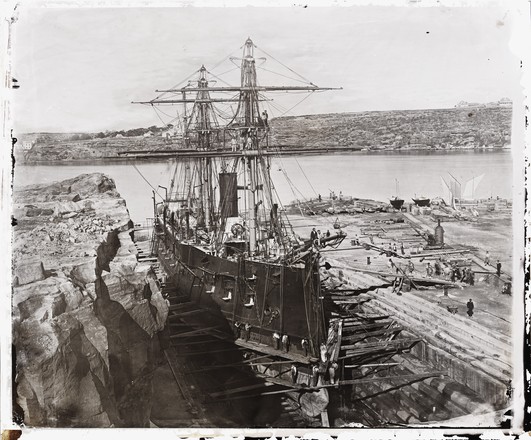French warship 'Atalante', Fitzroy Dock, Sydney, 1873
1873
Glass photonegative
Merlin was pleased with this photograph of the French ironclad Atalante in Fitzroy Dock. In the Town and Country Journal, 23 August 1873, he wrote:
Probably there is no one more difficult to please in procuring a picture of this kind than the landscape photographer himself. I may therefore be permitted to say in behalf of the one referred to, that it gave me satisfaction.
With a crew of 316, Atalante had an impressive armament, including six massive 194 mm breech-loading guns, four in a central battery below deck and two in barbettes on the upper deck. These could hurl a 75 kg shell over seven kilometres. At the bottom of the photograph is the solid brass ramming bow, weighing 20 tonnes.
From the Australian Town and Country Journal, Saturday 23 August 1873
" Vive le Roi," " Vive l'Empereur,"
" Vive la Republique," "Vive Thiers," " Vive M
Mahon," vive-what will be the next vive of la Grande Nation? The
associations, historical and social, connected with these cries, caused great
perplexity in my mind while looking at the iron-coated monster, now lying in
the marine hospital at Biloela. I thought, too, of gay, brilliant, frivolous,
vivacious Paris of some five years ago, and then of stern, sacrificing, heroic,
besieged Paris of a later period... As the Atalanta lay solidly, I may say
solemnly, on her rests in the Fitzroy Dock, she reminded me of the great
creative power of Napoleon, the unfortunate, who seems to have raised his
beloved France to too enviable a military eminence—to a height which first
generated European distrust, and finally led to her recent humiliation. The
great war ship, though proudly flying the tricolour, and beautiful in her
strength, inspires me with a feeling of sadness as the Imperial prestige is
gone; the splendid vessel is not therefore, a type or symbol of concentrated
sovereign power. It suggests nothing about the Republic of a hopeful rosy hued
kind. One thinks while looking at it of the sombre, dark, often-suffering man,
whose busy brain brought her and many others of her class into existence, and
who had such vain trust in his mighty fleet. [Beaufoy Merlin, “The French
Ironclad, Atalanta”, Australian Town and Country
Journal, Saturday 23 August 1873 p 17]



 Back to list
Back to list